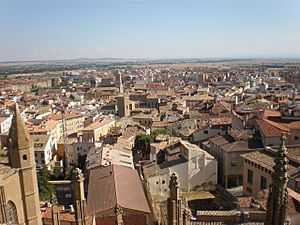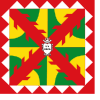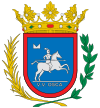Huesca facts for kids
Quick facts for kids
Huesca
Uesca (Aragonese)
|
|||
|---|---|---|---|

The city of Huesca as seen from the cathedral
|
|||
|
|||
| Motto(s):
Gate of the Pyrenees
|
|||
| Country | |||
| Autonomous community | |||
| Province | Huesca | ||
| Comarca | Hoya de Huesca | ||
| Judicial district | Huesca | ||
| Founded by | Iberians | ||
| Government | |||
| • Type | Mayor-council | ||
| • Body | Ayuntamiento de Huesca | ||
| Area | |||
| • Total | 161.0 km2 (62.2 sq mi) | ||
| Elevation | 488 m (1,601 ft) | ||
| Population
(2018)
|
|||
| • Total | 52,463 | ||
| • Density | 325.86/km2 (843.97/sq mi) | ||
| Demonym(s) | Oscense | ||
| Time zone | UTC+1 (CET) | ||
| • Summer (DST) | UTC+2 (CEST) | ||
| Postal code |
22001 - 22006
|
||
| Dialing code | 974 | ||
| Patron Saints | Saint Lawrence Saint Vincent |
||
| Website | Official website: http://www.huesca.es/ | ||
Huesca (also known as Uesca in Aragonese) is a historic city in north-eastern Spain. It is located in the region of Aragon. Huesca is the capital of the province that shares its name. It is also the main city of the comarca called Hoya de Huesca.
In 2009, about 52,000 people lived in Huesca. This was almost a quarter of everyone living in the entire province. Huesca is one of the smallest provincial capitals in Spain. The city celebrates its main festival, Fiestas de San Lorenzo, every year from August 9 to 15.
Contents
History of Huesca
Huesca has a very long history, going back even before the Romans arrived.
Early Times: Bolskan and Osca
Long ago, the city was known as Bolskan in the ancient Iberian language. It was the capital for a group of people called the Vescetani. The city was an important stop on old roads that connected major cities like Tarraco (today's Tarragona) and Ilerda (today's Lleida) to Caesaraugusta (modern Zaragoza).
During Roman times, the city was called Osca. A Roman leader named Quintus Sertorius made Osca his main base. He even started a special school there. This school taught young Iberians about Latin and Roman ways of life. Osca also made its own coins. Later, the Roman Emperor Augustus officially made Osca a municipium around 30 BC. This meant it had its own local government.
Arab Rule and the Reconquest
In the late 8th century, Arab forces took control of the city. They called it Washqah (وشقة). It became part of the Emirate of Córdoba. For many years, different local families and leaders fought for control of Washqah. They wanted more power and independence from the main Emirate.
In the mid-10th century, the city was given to the Banu Tujib family. They ruled the area from Zaragoza. In 1018, Washqah became part of the Taifa of Zaragoza. This happened when the Banu Tujib broke away from the weakening Caliphate.
In 1094, Sancho Ramirez, the King of Aragon, tried to conquer Washqah. He built the Castle of Montearagón nearby to help with the siege. However, he was sadly killed by an arrow while trying to take the city. His son, Peter I of Aragon, finally conquered Huesca in 1096.
University and Modern History
In 1354, King Peter IV of Aragon started the University of Huesca. At first, it only taught theology. The university grew over time, but by the late 1500s, the University of Zaragoza became more important. The University of Huesca was eventually closed in 1845.
During the Spanish Civil War (1936–1939), Huesca was a very important battleground. This area was known as the "Huesca Front." There was intense fighting here between the Republicans and General Franco's army. The city was surrounded by Republican forces, including the famous writer George Orwell. However, the city was never captured.
Images for kids
See also
 In Spanish: Huesca para niños
In Spanish: Huesca para niños







